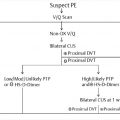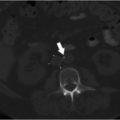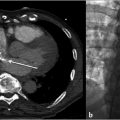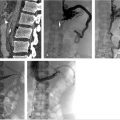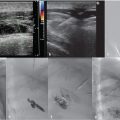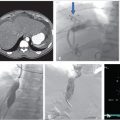8 Peripheral Venous Insufficiency
Summary
This chapter provides guidelines for the evaluation, management, and treatment of patients with chronic venous insufficiency, with two comprehensive case discussions, demonstrating the range and complexity of patient presentations. The chapter presents a useful algorithm for clinical evaluation, ultrasound interrogation, and treatment selection. There is a comprehensive overview of management approaches, as well as presentation of the technical details of procedural management.
8.1 Introduction
Peripheral venous insufficiency is underdiagnosed and is often unrecognized. It affects an estimated 25 million U.S. adults, with 20% of those progressing to end-stage disease. Evaluation and management of a patient with peripheral venous insufficiency follows a straightforward algorithm using both clinical and radiological expertise.
No one clinical specialty treats venous disease. Podiatrists, dermatologists, vascular surgeons, and interventional radiologists, among others, all are involved in the evaluation and treatment of peripheral venous insufficiency. Given the multidisciplinary nature of treatment, many societies have published guidelines and criteria for evaluation and treatment. This can be a source of confusion to the beginning practitioner who must sort through multiple societal guidelines. The American College of Phlebology (ACP), Society for Interventional Radiology (SIR), American Venous Forum (AVF) and Intersocietal Commission for the Accreditation of Vascular Laboratories (ICAVL) are recommended resources.
8.2 Case Vignette 1
8.2.1 Patient Presentation
A 52-year-old man presented with a large painful left calf and pretibial varicosity. The varicosity initially developed in his late 20s, and it has been slowly progressive. When the patient first noticed the varicosity, he was completely asymptomatic. In his late 40s, the patient developed increasing discomfort related to the varicosity, starting as a tingling and aching sensation before progressing to a burning pain. The varicosity became increasingly symptomatic, eventually becoming disruptive to his daily activities. The patient is required to stand for prolonged periods of time at work, which became increasingly limiting to his required activities. He had worn compression socks for 2 years prior to presentation, usually the calf-high athletic type. The symptoms improved significantly with elevation, leading him to seek to elevate his legs at every opportunity.
8.2.2 Physical Exam
A 4- to 5-mm bulging varicosity extended over the left medial calf and pretibial region, extending from the level of the patella to the distal calf, with multiple reticular veins and telangiectasias within the anterior lower calf. Small aneurysmal dilatations were seen, presumably representing dilated, incompetent venous valves. Physical exam findings were highly suggestive of great saphenous vein (GSV) reflux supplying this enlarged branching varicose tributary.
8.2.3 Noninvasive Testing
An upright duplex ultrasound exam was performed, demonstrating a dilated GSV measuring 11 mm at the saphenofemoral junction (SFJ), with greater than 500 ms of reflux documented. A large varicose tributary measuring 6 mm in diameter was demonstrated, correlating to the visible and painful varicosity evident on physical exam. At the midcalf, there was a 2-mm incompetent perforating vein, which supplied an overlying 3-mm varicosity. A second 5-mm varicosity within the lower calf was identified with origin not determined. The small saphenous vein (SSV) was normal in caliber without retrograde flow. There was no deep vein thrombosis (DVT).
8.2.4 Initial Management
The patient was prescribed medical grade thigh-high compression stockings providing 20 to 30 mm Hg of compression. In the absence of venous ulceration or recurrent superficial thrombophlebitis, the majority of third-party payers require a minimum 3-month trial of conservative therapy consisting of medical grade (20–30 mm Hg) compression stocking use, exercise program including walking, periodic leg elevation, and the use of over-the-counter pain medications. A past history of compression stocking use often does not contribute toward the patient’s insurance approval, as many insurance carriers require a supervised conservative therapy program under the care of the treating physician. However, if the patient notes symptoms have responded favorably to prior compression stocking use, the treating clinician can reasonably conclude the patient’s symptoms are related to venous congestion and may improve with future therapy.
Following 3 months, the patient returned for follow-up evaluation. Although the compression stockings provided him some relief, symptoms of leg pain, throbbing, burning, and pruritis quickly returned when compression was removed.
After documenting failure of symptom resolution with conservative measures, treatment options were discussed with the patient, including continued daily compression stocking use as well as endovenous ablation. The patient elected to proceed with GSV ablation.
8.2.5 Specifics of Consent
The key concerns to discuss with the patient prior to endovenous ablation are DVT, nerve injury, pain, swelling, bruising, and treatment failure. Endovenous saphenous vein ablation carries a small (1–2%) risk of DVT, which is discussed at length with the patient. Saphenous vein thermal ablation is associated with a slight risk of nerve injury, usually transient if access is performed at the level of the midcalf or above. Patients are counseled to expect varying degrees of tenderness, bruising, and swelling. Patients are also informed that a small percentage of patients may not experience relief of their symptoms following treatment.
8.2.6 Details of Procedure
GSV thermal ablation was performed as described in detail in this chapter. A follow-up postprocedure ultrasound was done to exclude DVT and extension of heat-induced thrombus (EHIT) as well as to assess for adequate vein closure.
Following ablation and while still supine on the procedural table, thigh-high 20 to 30 mm Hg compression stockings were applied. If the patient is unable to wear stockings, various methods are used to provide postprocedure compression including elastic bandages, gauze wraps, self-adherent inelastic dressings, and knee-high compression socks.
8.2.7 Follow-up
Thigh-high compression was prescribed for 7 to 10 days postablation. The patient returned to clinic 1 month following GSV ablation and demonstrated regression of the bulging varicosity previously supplied by the GSV. Small residual symptomatic varicosities present in the lower leg were managed with ultrasound-guided foam sclerotherapy. Three months following treatment, the patient returned to clinic and noted complete resolution of his symptoms.
8.2.8 Periprocedural Troubleshooting and Decision Points
In this patient, the dominant decision points were regarding whether to proceed with ablation alone, ablation plus phlebectomy, or ablation plus phlebectomy with ultrasound-guided foam sclerotherapy. There is a variable approach to these types of vessels. Although there is literature support for performing phlebectomy with ablation in the same visit, many patients can experience excellent clinical results with endovenous ablation alone, obviating the need for phlebectomy. The benefits of ablation alone are a shorter procedure time and fewer incisions and scars. The benefits of performing phlebectomy concurrently with ablation are the elimination of all residual varicosities in one visit and the prevention of the pain and hyperpigmentation of superficial thrombophlebitis, which may occur if there is delay in performing phlebectomy after GSV ablation.
8.3 Epidemiology and Scope of the Problem
Peripheral venous insufficiency affects an estimated 25 million U.S. adults, with 25% of those progressing to chronic venous disease with skin changes and healed or active venous ulcers. Six percent of adults in the United States have more advanced chronic venous disease consisting of skin changes including hyperpigmentation and/or lipodermatosclerosis with active or healed ulcers. Eighty percent of lower extremity ulcers are venous in nature. Peripheral venous insufficiency is underdiagnosed and is often unrecognized. Evaluation and management of a patient with peripheral venous insufficiency follows a straightforward algorithm using both clinical and imaging expertise.
Endovenous thermal ablation was FDA approved in 1999. Due to the ease of the procedure, favorable outcomes, low complication rates, and ability to perform thermal ablation in an office setting, venous stripping fell out of favor rapidly and thermal ablation was adopted across specialties. There are two thermal ablation modalities available in the United States for endovenous ablation; radiofrequency (RF) and laser energy. RF and 1,480-nm laser are comparable in terms of outcomes and complications, with improvements in outcomes seen with transition from a laser frequency of 810 nm, which was associated with a higher reported rate of bruising and postprocedure pain.
Because there are so many involved societies and a wide variety of practitioners, there are large gaps in data which can be somewhat confusing for the beginning practitioner, such as: How long does the patient wear compression stockings following treatment? How quickly will symptoms subside? What are expected outcomes? Most practices differ, with the more advanced practitioner tailoring his/her practice based on past experiences.
8.3.1 Patient Presentation and Evaluation
Patient presentations may be extremely variable. Prior to a discussion of the detailed evaluation of the individual patient, a review of the lower extremity venous anatomy is provided in order to form a basis for discussion.
Anatomy
A detailed understanding of the lower extremity venous anatomy is of critical importance to any practitioner wishing to intervene on the venous system.
The venous system in the lower extremity is divided into the superficial and deep systems. The superficial system is comprised of the GSV and the SSV. The GSV courses from the inguinal crease along medial leg to a point posterior to the medial malleolus. The GSV is found within the saphenous compartment, between the superficial fascia and the deep fascia. Any vein seen outside of this compartment is a GSV tributary, and if the “GSV” extends outside of this compartment it is no longer called the GSV. If the compartment is empty, the GSV is considered atretic in that segment. The saphenous compartment demonstrates a classic “Egyptian eye” appearance. The GSV is most easily located at the SFJ; it then can be followed peripherally down the leg with focus on the saphenous compartment.
Two common accessory veins are the anterior accessory great saphenous vein (AAGSV) and posterior accessory great saphenous vein (PAGSV). The AAGSV and the PAGSV parallel the saphenous vein originating near the SFJ and course toward the anteromedial (AAGSV) or posteromedial (PAGSV) thigh. The AAGSV can be seen on physical exam in a typical location running across the anterior thigh. The PAGSV is typically seen running across the posterior thigh. The PAGSV is any venous segment that extends parallel to the GSV and is posterior; the AAGSV is any venous segment being parallel with the GSV and is located anteriorly. Both the AAGSV and PAGSV are by definition found within the saphenous compartment. The AASV and PPSV may demonstrate reflux, and may develop varicosities, and if so should be treated in the same manner as the GSV. There may be clinical failure despite technical success in treating the GSV in the setting of an untreated incompetent accessory GSV. The accessory GSVs usually have a proximal straight segment supplying tortuous varicosities distally.
The deep system of the leg is comprised of the common femoral vein, femoral vein, popliteal vein, posterior tibial vein, peroneal vein, and anterior tibial veins. Reflux can be found within this deep system due to primary valve failure or often due to prior DVT leading to damaged and scarred venous valves.
Perforators are small short veins that connect the deep system to the superficial system, and these are named according to location. Huntington’s perforators are found in the proximal thigh, Dodd’s perforators are found in the distal thigh, Boyd’s perforators are found around the knee, and Cockett’s perforators are found within the posterior calf. Perforators physiologically flow from superficial to deep, but can reflux. This is of particular importance in cases of venous ulcers. When perforators are visualized, the direction of flow should be determined. If the direction of flow is going from a refluxing superficial system into the deep system, then this is called a reentry perforator, where the perforator is serving to decompress the superficial system by emptying blood into the deep system. However, if flow is from the deep system to the superficial system, this indicates that a point of abnormality is actually within a refluxing perforator and is the source of the physiologic abnormality. These refluxing perforators should be treated.
The vein of Giacomini is a variant important to the treatment of venous insufficiency. Also called the intersaphenous vein, the vein of Giacomini connects the GSV to the SSV, coursing along the medial posterior thigh. Reflux within this segment must be identified and treated.
The superficial system normally connects to the deep system in the following locations: (1) in the inguinal region where the GSV connects with the femoral vein, forming the SFJ; (2) in the posterior knee where the SSV connects with the popliteal vein at the saphenopopliteal junction; (3) perforating veins in the thigh and lower leg. An understanding of each patient’s anatomy is imperative in forming a successful treatment plan.
It is recommended that new practitioner perform diagnostic and mapping ultrasound until he/she fully understands the anatomy and complexity of the lower extremity venous pathways.
8.3.2 Decision Making
Once the anatomy is understood, an algorithmic approach to the patient may be applied. First, start with the clinical status. With the information provided during the history, evaluate the symptoms: duration, quality, severity, location, and exacerbating and ameliorating factors.
Obtain a thorough patient history including family history of venous disease, personal history of DVT, compression use, superficial venous thrombus, coagulation disorder, and detailed description of lifestyle limitations. Symptoms of venous insufficiency include lower extremity heaviness, fatigue, pain, cramping, pressure sensation, burning and itching, swelling, and restless leg symptoms. Symptoms usually occur when standing and worsen throughout the day. Symptoms are exacerbated by warm weather and are relieved by leg elevation and exercise that included calf muscle-pump activity. Symptoms of venous insufficiency must be differentiated from other disease processes causing leg pain or discomfort including peripheral arterial disease, arthritis, and neurogenic conditions.
The traditional textbook notion of arterial disease being worse at night, when the legs are elevated on the bed, and venous disease being worse during the day, while the patient is upright, is not reliable. Patients with venous insufficiency can describe symptoms worse at night, even preventing sleep. Although the legs are elevated, the symptoms of aching and throbbing will persist. Venous insufficiency is often misdiagnosed as “restless leg syndrome” as the patient complains of itchy, burning legs at night resulting in constant leg movement. This is thought to represent the typical symptoms of venous disease exacerbated by the heat of sheets or blankets. Patients will often describe kicking the blankets off of their legs. Any patient with restless leg syndrome and signs of venous insufficiency should be evaluated for reflux.
8.3.3 Physical Exam
Patients with venous insufficiency often demonstrate characteristic physical exam findings. These include lower extremity swelling and typical cutaneous manifestations of tissue congestion and damage. Cutaneous manifestations of chronic venous insufficiency are edema, hyperpigmentation, venous eczema (stasis dermatitis), lipodermatosclerosis, atrophie blanche, and venous ulceration. Cutaneous manifestations are progressive and graded according to the CEAP classification (Table 8.1). The pathophysiology of cutaneous manifestations relates to tissue level venous hypertension resulting in microcirculatory changes and inflammation.
With venous congestion, capillary dilatation occurs and recruited white blood cells release inflammatory mediators. Edema demonstrates a typical pattern in the perimalleolar region and ascending up the leg. The edema does not extend into the foot. This is an important physical exam finding which helps to differentiate venous edema from lymphedema. Continued swelling then leads to a cycle of increased permeability and capillary damage. Symptoms are often worse in hotter climates due to increased capillary dilatation.
Inflammatory changes are thought to occur because white blood cells are trapped due to increasing blood flow; these white blood cells accumulate and release toxic oxygen metabolites and proteolytic enzymes, which lead to further capillary damage, increased permeability, microlymphatic damage, and ultimately fibrin formation. At the microcirculatory level, increased capillary diameters, decreased capillary number, and endothelial damage are seen. The increased capillary permeability also leads to accumulation of extravasated red blood cells within the interstitial space.
In patients with lipodermatosclerosis, in addition to increased white blood cell accumulation, proinflammatory cytokines such as IL-1A and IL-IB are present. Lipodermatosclerosis is characterized by hyperpigmentation and fibrosis of the dermal and subcutaneous tissues and demonstrates a high association to chronic venous insufficiency. Chronic congestion leads to pericapillary fibrin formation, which leads to decreased oxygen diffusion. These changes inhibit new collagen formation, which impairs healing, and hence, nonhealing ulcers.
Dry skin and pruritus are often associated and can lead to venous eczema, which is a pruritic process usually beginning at the level of the ankle and again rising cephalad.
Superficial telangiectasias and spider veins are often present. On ultrasound, these rarely demonstrate a visible connection to the deep system and are not specifically indicative of reflux, except in cases of corona phlebectatica. Corona phlebectatica is a cluster of normally visible cutaneous vessels within the medial ankle. Corona phlebectatica has been found to correlate with the clinical severity and hemodynamic abnormalities of chronic venous insufficiency. Although it is not included in the CEAP classification, there is a strong correlation with underlying hemodynamic venous disturbances.
Venous ulceration is the end stage of chronic venous insufficiency. An estimated 20% of chronic venous insufficiency patients will develop venous ulcers; 1 to 4% of the U.S. adult population has had an active or healed ulcer, and 80% of lower extremity ulcers are venous in nature. Many physicians and care providers do not recognize venous ulcers for what they are; 40% of patients with venous lower extremity ulcers have an open ulcer for over 1 year. Many practitioners will recognize these as “stasis ulcers,” yet be unaware that these are venous stasis ulcers. Many patients spend months and months undergoing painful debridement and wound care appointments, without the ulcers being recognized as venous in etiology. Venous ulcers occur within the medial malleolar region and this location is nearly pathognomonic for venous stasis.
Understanding the patient’s symptom complex and based on physical exam, some conclusions may be drawn. The next step is obtaining a thorough lower extremity venous duplex. Duplex sonography evaluating a patient for superficial venous insufficiency is distinct from an examination to evaluate for DVT. The overwhelming majority of patients who have a previous venous duplex will report a normal ultrasound examination. Lower extremity duplex sonography performed at hospitals and imaging centers will examine the deep system in order to exclude DVT. Rarely is the superficial system or the presence or absence of deep venous reflux evaluated. Do not let the history of a “normal ultrasound” deter from pursuing a specialized ultrasound to evaluate for GSV reflux.
Stay updated, free articles. Join our Telegram channel

Full access? Get Clinical Tree



